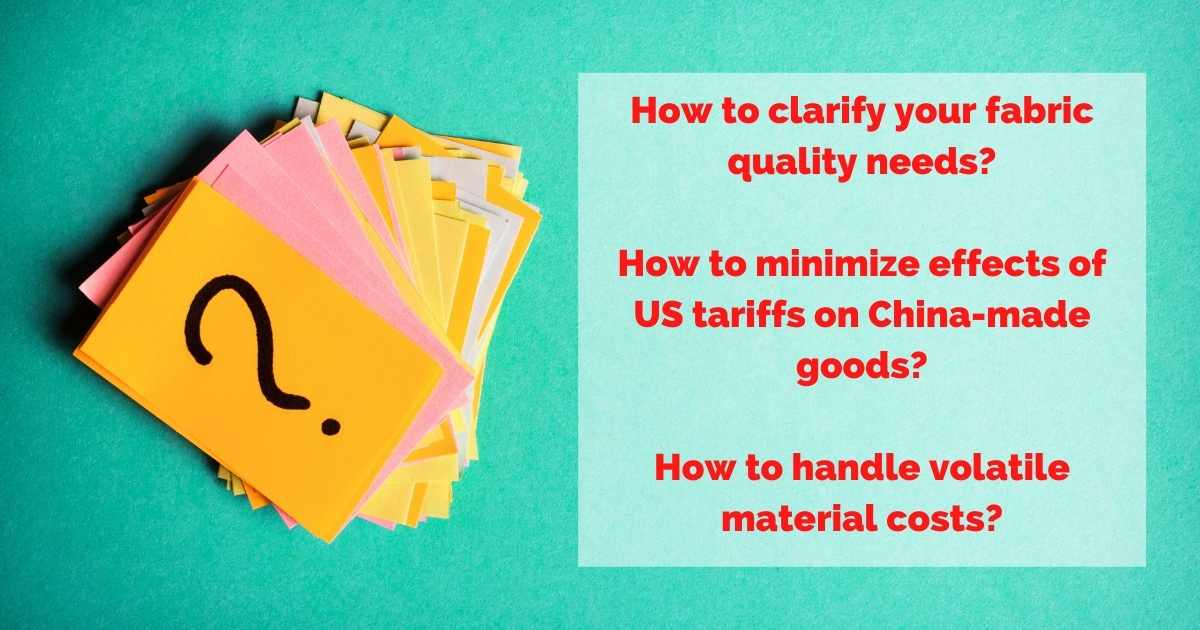In this episode…
Renaud answers 3 great questions that came in from our listeners, assisted by Adrian from the Sofeast team.
He’ll cover how to communicate fabric quality to suppliers, tactics for coping with US tariffs on China-made goods, and strategies to cope with volatile material and shipping costs today.
Just hit the play button to start listening..!
Listen to the episode right here 👇👇👇
Show Sections
00:00 – Greetings & Introduction
01:43 – How to communicate the quality of materials/fabrics you want to buy to your supplier..? There are qualitative aspects that are outside a fabric spec description.
In the case of materials for producing soft goods, a specification sheet is not enough. Physical samples of the materials will be critical for reference by your supplier, inspectors, etc, to illustrate your quality standard. The written word can’t describe touch and feel and colors adequately in comparison. Renaud outlines the process it takes to get to a final approved fabric sample that embodies your quality standard, from early lab dips through to pre-production samples, including some of the requirements that buyers usually specify (often gathered into a tech pack in N. America).
13:02 – How to minimize tariffs on China-made goods imported to the USA under our brand?
Mislabelling the products and shipping via Vietnam etc to repackage them is a no-no. It may be possible to reclassify your product to one that is subject to lower or no tariffs, especially if adding or removing a feature to do so during product development. Consult a lawyer about this. Sell products to customers who are less price-sensitive. This will be more effective if your product is unique, has fewer competitors, or you’re able to charge a premium and pass on extra costs to customers due to the quality and/or features of your product.Getting creative with product design, manufacturing processes, using cheaper materials, removing functions, making a special edition version, etc, are ways to cope with tariff costs, too. Packaging may be altered or reduced to lower costs, too.
24:58 – Any tactics for handling volatile material costs today?
Consider alternative lower-cost materials for products if possible. Make an inferior, but cheaper ‘lite’ version of a product that appeals to a different customer base. Research current material costs so you can challenge suppliers who raise prices outside of what is reasonable.
32:03 – Is China as affected by energy cost rises as other regions these days?
China is not suffering from large energy cost rises like Europe is, for example, as a lot of energy for manufacturing and the economy comes from coal, not oil and gas. Many factories not engaging in very energy-intensive activities like die casting are not very affected by energy cost rises now, so despite material cost increases being common in China, importers with Chinese supply chains probably won’t also be negatively impacted by their suppliers’ energy costs, too. Chinese economic activity is a bit flat these days and may also be helping to reduce China’s overall energy demands.
34:32 – Wrapping up.
Related content…
- Plastic, Silicone, Steel, and Others: Updated China Raw Materials Costs (Late Feb ’22)
- Rising Raw Material Prices: What Strategy To Follow? (6 Approaches)
- How To Cooperate With Your Chinese Supplier, Part 16: Bad News from China, Raw Material Prices Just Increased!
- How To Switch To A Newer, Better Chinese Manufacturer? [eBook]
Subscribe to the podcast
There are more episodes to come, so remember to subscribe! You can do so in your favorite podcast apps here and don’t forget to give us a 5-star rating, please:

